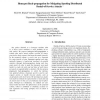Free Online Productivity Tools
i2Speak
i2Symbol
i2OCR
iTex2Img
iWeb2Print
iWeb2Shot
i2Type
iPdf2Split
iPdf2Merge
i2Bopomofo
i2Arabic
i2Style
i2Image
i2PDF
iLatex2Rtf
Sci2ools
JPDC
2006
2006
Honeypot back-propagation for mitigating spoofing distributed Denial-of-Service attacks
Any packet destined to a honeypot machine (that is, a decoy server machine) is most probably an attack packet. We propose honeypot back-propagation, a scheme that traces attack packets received by honeypots back to their source(s) and stops the attack source(s). In the proposed scheme, a server acts as a honeypot for some periods of time (honeypot epochs) and automatically triggers a hop-by-hop traceback of possible attackers (through back-propagation) during each honeypot epoch. In order to make the honeypots even much harder to evade, the start and end times of each honeypot epoch are unpredictable to attackers. We also propose progressive back-propagation, in which the information gathered during a honeypot epoch is used in subsequent epochs, to handle low-rate attacks, such as on-off attacks with short bursts. We developed an analytical model to estimate the expected time to reach and stop an attack source in the case of continuous and on-off attacks. Through ns-2 simulations, we ...
| Added | 13 Dec 2010 |
| Updated | 13 Dec 2010 |
| Type | Journal |
| Year | 2006 |
| Where | JPDC |
| Authors | Sherif M. Khattab, Rami G. Melhem, Daniel Mossé, Taieb Znati |
Comments (0)

